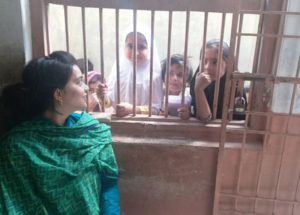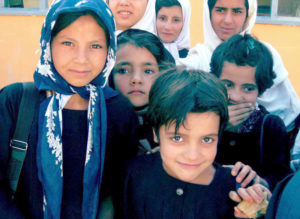Bridging the gender gap in education and reading in Pakistan
By Natalie LovenburgFebruary 28, 2017
Q&A with Shaheen Ashraf Shah, Ph.D., Gender Advisor for the USAID-supported Pakistan Reading Project
More than 32 million girls around the world don’t have access to education—often due to cultural, financial or other barriers. The problem is compounded in many crisis and conflict-affected countries, where security concerns mean girls are more likely to be kept at home.
Creative’s Gender Technical Advisor for the Pakistan Reading Project, Shaheen Ashraf Shah, Ph.D., shares her experiences addressing barriers in Pakistan and improving literacy education for all children, including those living amidst conflict and crises. It is funded by the U.S. Agency for International Development.
At the annual Comparative and International Education Society conference on March 7 in Atlanta, Shah will present on “Gender and Education Issues in Pakistan: Gaps, Bias, Teachers and School Conditions.” The session is from 4:30-6 p.m. in the Sheraton Atlanta 1, Georgia 1 (South Tower) room.
Along with education research expert from the U.S. Agency for International Development, Fatima Jinnah Women’s University, Columbia University, Ontario Institute for Studies in Education and the University of Texas, Shah will discuss how girls and boys are affected differently by various social, cultural and educational factors contributing to reading ability.
In her role as Gender Advisor for the USAID-supported Pakistan Reading Project, Shah focuses on ensuring that boys and girls have equitable access to literacy education and that teachers are equipped with gender-sensitive tools to help both boys and girls achieve optimal reading outcomes. In Pakistan, more than 6.7 million children are out of school – of which 62 percent are girls.
Previously, Shah worked as a social and gender specialist with various national and international development organizations. She is an active member of civil society in Pakistan–extensively researching, speaking, writing and presenting on gender and development issue in Pakistan and abroad. She holds a Ph.D. in Women and Gender Studies from the University of Warwick.
For a full schedule of Creative’s CIES 2017 panels, including panelists, times and locations, click here. Follow @1977Creative and #CIES2017 on Twitter for up-to-date panel coverage.
In addition, on March 10 Shah will also be speaking on gender equitable education and the Pakistan Reading Project at Creative’s Washington, D.C. headquarters. For more information or to RSVP, click here.
When did you first realize that you wanted to work in the gender field?

Shah: I was raised in a very poor, rural family in Pakistan’s Sindh province, and I have observed and experienced firsthand how women and vulnerable groups suffer because of gender bias, especially in my own community.
A desire to assist others, especially the most marginalized groups of society whose voices are often ignored, brought me to the development sector. I left my university teaching career and joined Pakistan’s largest Rural Support Program in terms of outreach, staff and development activities. I was impressed with the organization’s participatory development approach and the direct interaction with communities.
What types of cultural barriers do girls face in receiving an education in Pakistan?
Shah: In a patriarchal society like Pakistan, girls face additional cultural barriers to education. For instance, girls represent only 35 percent of students in rural areas and 42 percent in urban areas. School dropout rates and poor access to education for girls is exacerbated by early marriage, wearing the pardah [veil], requiring permission by elder men [to attend school], mobility concerns and social expectations—all contribute to creating barriers to receiving an education.
Safety is a big concern for girls since schools are often far away from homes, transportation is not reliable and girls are frequent targets of physical and sexual exploitation. Often schools lack proper infrastructure to keep girls safe, and school expenses (books, uniforms, fees, etc.) act as a deterrent for parents to send their children to school. Often, girls and women have the responsibility to handle domestic chores and some girls are forced to stay at home.
How does conflict and crisis disrupt children’s access to quality education?

Shah: In Pakistan, we have witnessed a negative impact on education–especially in areas badly affected by war and terror, conflict and displacement. For instance, in Pakistan’s Balochistan and FATA [Federally Administered Tribal Areas] Provinces, the number of girls enrolled in primary education is the lowest in the country.
In terms of out-of-school children, both Balochistan and FATA have again the highest number of children not attending schools, of which 75 percent are girls. Children have lost many years of education due to conflict and crisis. Pakistan’s government is still coping with the aftermath of conflict and rebuilding an education infrastructure. Access to quality education in conflict affected areas requires special attention.
What is Creative doing to combat gender inequalities in education through the Pakistan Reading Project, and what can governments and other organizations do?
Shah: Creative’s Pakistan Reading Project is a unique project, promoting and implementing a quality education–especially in literacy in national and regional languages. Pakistan is a very diverse society, where each region and province has its own language, history, culture and nature. However, there remains disparities in treating all languages equally.
Creative’s quality education work and the Pakistan Reading Project’s major focus on national and regional languages certainly contributes toward equality agendas. I believe the Pakistani government and other organizations can play a vital role in eliminating gender disparities, encouraging gender sensitivity and achieving global gender equity.
What are some other initiatives that have worked to improve education in Pakistan?
Shah: After Pakistan’s political transition of passing the 18th amendment, education no longer falls under federal government. Now, provinces oversee education initiatives. There are overarching general challenges and also many region specific barriers in providing better educational facilities.
Provinces have already formulated region-specific educational policies and plans meeting their needs. We have observed that increasing education budgets, investing in teachers’ training and building infrastructure development grows school enrollment numbers, especially for girls. The most rewarding thing is to observe policymakers in Pakistan recognize the issue of access to quality education and gender disparity in education, and see this reflected in various policies and plans.
For a full schedule of Creative’s CIES 2017 panels, including panelists, times and locations, click here. Follow @1977Creative and #CIES2017 on Twitter for up-to-date panel coverage.
In addition, on March 10 Shah will also be speaking on gender equitable education and the Pakistan Reading Project at Creative’s Washington, D.C. headquarters. For more information or to RSVP, click here.
To visit Creative’s CIES 2017 Special Report hub, click here.

